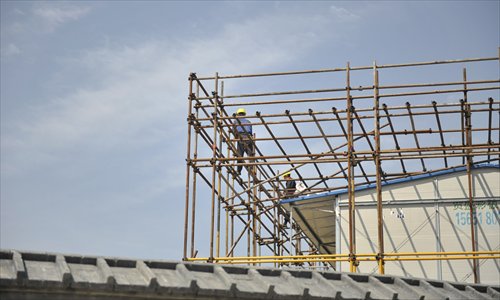HOME >> BUSINESS
Investment slows to 15-year low
By Liang Fei Source:Global Times Published: 2015-6-11 23:08:02
More govt support required: experts

Workers at a construction site in Nanjing, capital of East China's Jiangsu Province Photo: CFP

Growth in China's fixed-assets investment, a major driver for the economy, dropped to a 15-year low of 11.4 percent in the first five months of this year, official data showed Thursday, increasing pressure for new support measures to curb the economic slowdown.
The level for the first five months was 0.6 percentage points lower than for the January-April period, according to data from the National Bureau of Statistics (NBS).
Investment in infrastructure increased 18.1 percent year-on-year in the first five months amid the central government's efforts to boost infrastructure construction, but even this growth rate was 2.3 percentage points lower that for January-April, the NBS data showed.
A lack of funds is the major factor behind the slowdown in fixed-assets investment, and the central bank should roll out more monetary easing measures to bolster growth, Liu Xuezhi, an analyst with Bank of Communications, told the Global Times Thursday.
Liu noted that other financing tools, such as local government bonds and the public-private partnership model for encouraging private investment, should also get more support from the government to aid growth.
Other economic data released Thursday also pointed to downside risks facing the economy. Despite the recent rebound in property sales, growth in property investment dropped to 5.1 percent year-on-year in January-May, 0.9 percentage points lower than that in the first four months, according to the NBS.
Industrial output rebounded moderately to 6.1 percent year-on-year in May, but "it is uncertain whether the upward trend in industrial output will continue," Liu noted.
The figures released Thursday follow the same trend as other major economic data released earlier in the week. Total trade dropped 9.7 percent year-on-year in May, customs data showed on Monday, with a greater-than-expected 18.1 percent slide in imports.
Also, the consumer price index dropped back to 1.2 percent last month, the NBS said Tuesday, indicating that the risk of deflation has not yet passed, experts said.
"More stimulus policies are needed," Xu Hongcai, director of the Economic Research Department at the China Center for International Economic Exchanges, told the Global Times on Thursday.
Xu noted that the central bank should ease monetary policy soon, ideally in June, with a cut in banks' reserve requirement ratio the most likely option. Also, the government should be more proactive with fiscal spending in order to encourage more private investment in key projects.
The People's Bank of China (PBC), the central bank, has cut interest rates three times since November 2014 and lowered the reserve requirement ratio twice.
Besides monetary easing, the government has also stepped up fiscal spending to support the economy. The National Development and Reform Commission said Wednesday it had approved seven new infrastructure projects worth more than 120 billion yuan ($19.3 billion).
Detailed measures to spur trade and consumption were also introduced earlier this month. For instance, the import tariffs for some consumer goods were lowered on June 1, which experts said would help boost domestic consumption.
China's economic growth slowed to a six-year low of 7 percent in the first quarter. Central bank economists adjusted their 2015 GDP forecast to 7 percent from the previous 7.1 percent, according to a report released by the PBC on Wednesday.
However, experts said that the slowdown is expected to bottom out in the second quarter, with recent stimulus policies likely to gradually take effect. The PBC report held a similar view, noting positive factors like a further recovery in the global economy, the rebound in property sales and the government's support measures.
Posted in: Economy